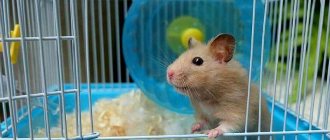Do hamsters stink?
There is no dependence on the breed. In terms of cage care, Syrian hamsters, Djungarian and other breeds are equivalent. Their home needs to be cleaned with equal frequency - at least twice a week.
Important! The Syrian breed is larger than the Dzungarian breed, which is why such a hamster produces more waste. However, when it comes to odor, it is not the quantity that is important, but the “age” of the accumulated feces. They begin to stink after a few days, and it is the same for all breeds.
Similarly, the hamster’s smell is not affected by its gender and age. Males and females are equally clean. Caring for them is the same, and the animals themselves carefully monitor the cleanliness of their coats.
If the cage is clean, then there is nothing to stink.
The animal is unwell
A hamster is too small to smell when sick so that it is noticeable to the human sense of smell, and even more so - it hits the nose even when approaching the cage. In addition, the signs of the disease are quite noticeable (here, smell alone is rarely enough), and hamsters get sick at lightning speed due to their high metabolic rate. That is, a hamster cannot get sick - and at the same time have clear eyes, not inflamed or scratched skin and, most importantly, live a long time. For a hamster, we dismiss this reason as fantastic.
What to do if your hamster smells like urine
If the smell from your hamster leaves much to be desired, you need to understand the situation. There are not many reasons, and all are usually easily remedied.
Uncleaned cage
To line the tray, use a special filler for rodents, but in no case should newspapers or napkins be used. The fact is that paper, unlike filler, is not able to “lock in” the unpleasant smell of urine.
The reason why your hamster stinks may be due to irregular cleaning of his house. It is important not only to shake out the old bedding, but also to wash the tray itself, as well as the pet’s drinking bowl, feeder, and toys. If you do this at least twice a week, then the cage and the hamster itself will not smell. After all, a stinking odor can also be emitted by food debris that has clogged up in the bedding and corners of the home.
Important! There is no need to bathe the animals themselves; they carefully take care of themselves from birth and do not need bathing.
Stress and health problems
When a pet is just settling into its cage after being purchased from a pet store, this is a difficult time for it. You need to give him a few days to adapt. You should not pick up a hamster - both for adult family members and for children. Otherwise, unpleasant consequences may appear. Due to stress, the domestic rodent begins to mark its house. And then the smell, of course, will appear.
In a situation where the animal is very nervous, it needs to somehow calm down. The easiest way is to surround yourself with your own scent. This happens with hamsters too. It is best to leave your pet alone for a while, then the smell will disappear sooner.
Other reasons can be sources of stress: mating fights between males, the spring rutting season, as well as some kind of disease. If your pet starts marking everything in its house for no apparent reason, you should consult a veterinarian.
Smell from an uncleaned cage
The first, most common one is that it is not the furry animal that has a nasty smell, but its home. If the owner of a hamster does not regularly clean his hamster’s cage, then the smell will stagnate there and not very pleasant.
Rodent owners know: healthy animals do not have an unpleasant odor . Seven days after cleaning, a specific aroma appears, which tells the hamster owner that it is time to restore order: clean and wash the rodent’s cage. It is not the animal itself that smells bad, but its excrement.
The cause of the stench is the bedding in the cage. If you use old newspapers, hay or scraps of fabric, this litter will not retain odor or moisture. And in addition to this, it can become a source of various infections, which are dangerous for both the pet and its owner.
For bedding material, sawdust or fillers are suitable: wood, cellulose or corn. Each filler or different sawdust has its own positive and negative sides. Each type has its own expiration date, during which it will absorb moisture and absorb odor. If it is not replaced after a certain time, then even the best litter will begin to emit a foul discharge.
The sawdust in the hamster's cage is changed, as a rule, every 2-4 days. If the hamster lives in wood litter, then it must be removed once every 5-8 days. If it is corn filler, then the cleaning period is once every 7-10 days.
If you choose the right filler for your furry rodent’s cage and carry out regular cleaning, then there will be no question of a bad smell in the apartment from your pet.
How to prevent unpleasant odors
A few simple tricks will help reduce the time spent cleaning up after your hamster. It is impossible to do without this, of course. But every owner of these cute animals can make their life easier and remove the smell of hamsters.
Toilet training your pet
In a habitable house, the hamster usually chooses one corner (usually away from the drinking bowl and sleeping area) to relieve its natural needs. You can put a small tray with filler in this place. The first time the tray is sprinkled with already soiled filler, so as not to frighten the animal. This technique will help make the cleaning process a little easier.
It can be divided into daily and “general” - with washing the entire house, when the smell of hamsters is completely removed.
Important! The rodent does not immediately learn to allocate a separate corner for a latrine. It will take him 1–2 months to do this after moving into the cage.
Choosing the right filler
Corn litter is best suited for hamsters, since it is the type of litter that reliably blocks the smell of urine. With him, you will only have to clean the cage once every 10–14 days. Every week you have to clean out the wood filler (shavings, sawdust, pressed pellets).
Interesting! Small sawdust is not very suitable, as rodents love to scatter them, and the area around the house will always be dirty. But the worst thing is paper; it is usually its use as a filler that accounts for stinky hamsters.
What you need to remember to avoid unpleasant odors
- The pet's cage should be spacious enough. For large hamsters, the dimensions of his home should be 40 x 40 x 60 cm. For small breeds, purchase a slightly smaller, but still spacious cage 30 x 30 x 50 cm;
- use only good filler. Do not use cat litter or compressed kibble as an absorbent. Take straw or sawdust;
- The best odor absorber is corn filler. It can be changed once every two weeks. The rest, as a rule, at least once a week.
A hamster can be toilet trained!
These rodents are not only big clean people who constantly wash themselves, they are also clean in their own home. The hamster chooses a place for himself that he will use as a toilet room.
Take a closer look at where your hamster has such a place. Make your own tray for him to relieve himself. By cleaning and washing the litter box, you will save litter and clean the cage much faster.
You can take and cut a plastic bottle as a tray. To help your pet get used to the new interior detail, sprinkle a little used litter with traces of discharge on top. After a month or two, the hamster will get used to it and remember the place of its toilet.
How to get rid of hamster smell?
Many people are afraid to get a hamster for themselves or their children only because everyone (literally everyone!) they know, hearing about it, exclaims: “What are you doing?! It's a hamster! Your apartment will have SUCH a smell!” and they frown expressively.
Is this really so, is keeping a hamster necessarily associated with a stench, is it possible to reduce the scale of the disaster and reduce the intensity of the “hamster” smell (or even remove it completely), we will try to figure it out today.
There are few reasons for the occurrence of odors when keeping animals, they can be reduced to the following:
- something is rotting somewhere (food, cage floor, etc.),
- natural secretions (urine) smell
- the animal is unhealthy (including due to feeding with unsuitable foods).
Now let's deal directly with the hamster.
Odor control methods
To ensure that the lives of hamster owners at home are not poisoned by spoiled air, it is recommended to use high-quality litter as bedding. Corn, wood or cellulose are good options. You can also use regular sawdust, since it can absorb moisture, but in any case you will have to change it regularly, since it does not absorb odors. On average, animals can use sawdust for 2-4 days without disturbing the life of their owners with extraneous aromas. Using wood fillers for the cage, odors will not be noticeable for a little longer: from 5 to 7 days. The optimal corn option provides a sufficient level of comfortable existence for 10 days.
When a hamster is sick
There are times when the smell from a hamster intensifies or changes character. This can happen when the rodent gets sick. Various diseases can happen to pets, including those associated with improper care. Pay attention to the behavior of the animal, inspect the cage.
Signs of the disease may include decreased activity, loss of interest in food, as well as an unpleasant odor and changes in the condition of the coat. The hamster looks damp, bald or greasy and naturally begins to smell foul. If there are any concerning symptoms, you should immediately contact your veterinarian.
Sometimes hamsters can emit an unpleasant odor when scared. Animals also experience stress, just like people. This may be due to a sudden change in the situation, the arrival of new people and their increased interest in the pet. A messy cage can also make your rodent tense and wary.
Often, if several animals are kept in a cage, they begin to fight for territory and mark it. The rodent itself in such a situation also begins to smell stronger; these are the mechanisms for establishing hierarchy in nature. Hamsters thus establish the boundaries of their territory and transmit messages to their “neighbors.” In this case, it is better to place the animals in different cages or choose a larger house for them.
Thus, getting rid of hamster odors in an apartment is quite simple, you just need to understand the cause of the stench and eliminate it immediately. If your hamster smells, but the cause cannot be determined, the pet may be sick, in which case you need to contact a specialist who will determine the cause.
Does the hamster smell or how to get rid of the unpleasant rodent smell in the apartment 4.2 (84%) 5 votes
Hair loss and other diseases of hamsters
Dandruff, scratching and baldness in hamsters can be caused by ectoparasites, pathogenic dermatophyte fungi, endocrine system disease, and sometimes tumors. The severity and duration of skin diseases in hamsters depends on the cause.
Many of these diseases, such as dermatophytosis or lichen in hamsters , are contagious and can be transmitted to humans. Therefore, if you notice suspicious symptoms, immediately take your hamster to a veterinarian.
Hamsters are often troubled by Demodex , which can be transmitted from one hamster to another. Only a veterinarian can identify the cause and prescribe the correct treatment.
Abscesses are an accumulation of pus in a limited cavity. Pus accumulates under the skin, sometimes forming large, painful swellings on the surface of the hamster's body. Abscesses can form due to cuts and scrapes in the skin. If sharp food particles injure the wall of the cheek pouch, a cheek pouch abscess may develop, and the cheek will appear full all the time. Abscesses require treatment by a veterinarian.
Lymphocytic choriomeningitis is a disease of viral etiology; it can be asymptomatic in hamsters, but there is a danger of infection in humans. When buying a hamster for a child, remember the possible risks; conduct a preventive examination of the animal by a veterinarian.
Eye diseases in hamsters
Conjunctivitis is a fairly common eye disease in hamsters. The development of the disease in hamsters can be provoked by particles of sawdust or hay that get on the mucous membrane of the animal’s eyes, or by failure to comply with hygienic conditions of detention. Characteristic signs of conjunctivitis are discharge from the eyes, sticking of the eyelids. The animal experiences severe discomfort and scratching its eyes with its paws only aggravates the situation.
Treatment involves rinsing the eyes with saline solution or lotion and using specialized drops prescribed by your doctor.
Unpleasant odor from hamsters: what should you do to avoid it?
Many of us do not want to buy rodents because we believe stereotypes about the uncleanliness of these animals and refuse cute animals, without even thinking about whether hamsters actually stink.
Hamsters are the type of animal that washes itself for days; they are cleaner than cats. An unpleasant odor can indeed appear, and not only due to the fault of owners who do not pay due attention to caring for their pets. There may be several reasons. How to get rid of the hamster smell and why it appears will be discussed in this material.
Which breed smells less?
Hamsters themselves do not emit any odor, but your efforts to combat unpleasant odors are directly related to the size of the pet. If it is a large animal, then it will produce more excrement than a small one. This explains why the level of dirt in the cage of Syrian hamsters is higher, and they need to be cleaned more often.
It is also important to consider the length of hair in rodents. The longer it is, the more odors accumulate in it from contact with dirty filler. Even despite their cleanliness, hamsters cannot clean their long fur thoroughly enough, and this responsibility falls on the owners. This explains why Syrian hamsters' cages have to be cleaned more often.
The least problematic is keeping small rodents with short hair. These include Djungarian hamsters; such breeds are less difficult to care for.
Do all breeds smell the same?
Healthy hamsters in a calm mood do not smell. Large breeds of hamsters are believed to have stronger and more unpleasant odors. This is the opinion about Syrian hamsters. But this breed is relatively large rodents. They consume more food and, accordingly, excrete more waste products.
Long fur on the coat of Angora hamsters, for example, can also cause an unpleasant odor. No matter how the rodent cleans itself, the long pile of the skin absorbs various aromas well, including unpleasant ones.
Regardless of the breed, if your pet has an unpleasant odor:
- Clean up his cage and change the litter.
- Eliminate the stressful situation your hamster is in.
- Calm your pet.
- Pay attention to your hamster's diet.
- Take him to the vet so you don't miss anything serious in your pet's health.
Whether your pet has a specific smell because it is sick or for some other reason is a second matter, the main thing is to understand this and eliminate the cause, doing everything necessary so that your baby hamster lives in comfort.
Healthy hamsters live without a specific odor for their entire measured two or three years. The myth that these rodents smell bad was invented by lazy owners who don’t bother to tidy up their pets’ homes in a timely manner.
What I am a master at is talking incessantly about hamsters. I have three hamsters at home, and my husband has a pet rat. That’s how we live, the six of us eat, the six of us sleep :)
The smell comes from natural secretions (urine, feces, etc.)
This is the main reason that “hamsters smell.” In fact, the reason is not at all in hamsters (they are quite clean animals) - the reason is the lack of proper care. To prevent the smell, the owner will need:
- provide the hamster with sufficient living space;
- set up a “toilet” area away from the house and warehouse.
The main (and, in fact, the only one worthy of close attention) source of odor from a hamster is its urine. Therefore, the hamster must have a toilet that is easy to clean.
A “toilet room” for a hamster can be bought or made from scrap materials. Industrially produced toilets can be corner or free-standing, corner ones can be attached to the cage lattice or stand stably without attachment to anything (these are suitable for aquariums and for plastic cages with a plexiglass top).
For example:
- corner toilet, which is attached to the bars of the cage:
- corner toilet, which stands without fastenings:
- free-standing toilet:
As a toilet for the first time, if the animal suddenly appeared in your house, you can use a glass jar, placed on its side and supported with something on the sides so that it does not roll around the cage.
Why does everyone think that a hamster stinks? Yes, because for many these memories come from childhood, when the unfortunate animal lived in a three-liter jar. Naturally, in such conditions there was no question of equipping a toilet - which means that the urine was constantly in the jar, which contributed to the appearance of a strong odor.
There is no need to toilet train your hamster, as is done with kittens - just place the toilet in the corner that the hamster has already designated for toileting. You can pour a teaspoon of plain water into the bottom of the toilet - this will be a hint for the hamster, which he will not fail to use.
Cleaning the toilet with water without adding detergents is enough. When keeping one hamster, this is done once a day, pairs - twice a day, with a larger number of animals you will either have to wash it more often or install additional toilets so that there is enough space for everyone. Once a week, the toilet is washed with detergents, which (this is important!) must be rinsed thoroughly.
As for hamster poop, the animal is not able to pass it out in a specially designated place for this purpose, so the excrement will be mainly in the house and, little by little, on the floor of the cage. Fortunately, they have virtually no odor and are definitely not capable of creating a thick aroma that would scare people away from the cage.
Do hamsters smell and if so, why?
Anyone who has kept these rodents knows that an unpleasant odor from healthy hamsters does not appear immediately, but a week after cleaning. The time period can increase or decrease depending on the number of individuals in the cage. This indicates that it is time to clean and wash the cage, because healthy animals themselves do not have a smell - it is their excrement that accumulates.
To understand the reason for the unpleasant aroma of a hamster, you need to sniff the animal and the cage separately.
Why does the hamster itself stink:
- The smell came from dirty wool.
- The rodent is stressed.
- The pet is sick.
If nothing has changed after cleaning the cage, the reason is in the animal itself. Stress in pets occurs due to various reasons - loud noises, moving the house to a new place, or close attention from cats or other animals. Some breeds of rodents can emit a scent due to the fight for territory with other males (this is what “Syrians” do).
To return the fluffy to normal, you need to seat the partners in other cages or let him get comfortable in a new place. He will calm down and the inconvenience will disappear by itself.
A common cause of odor is gastrointestinal diseases from the wrong food that it is fed. This entails poisoning or indigestion. However, it happens that a Djungarian hamster or any other one stinks, despite the fact that it is fed exclusively with special food. In this case, the animal should be immediately taken to the veterinarian, because it may develop pneumonia, diabetes, or contract parasites.











